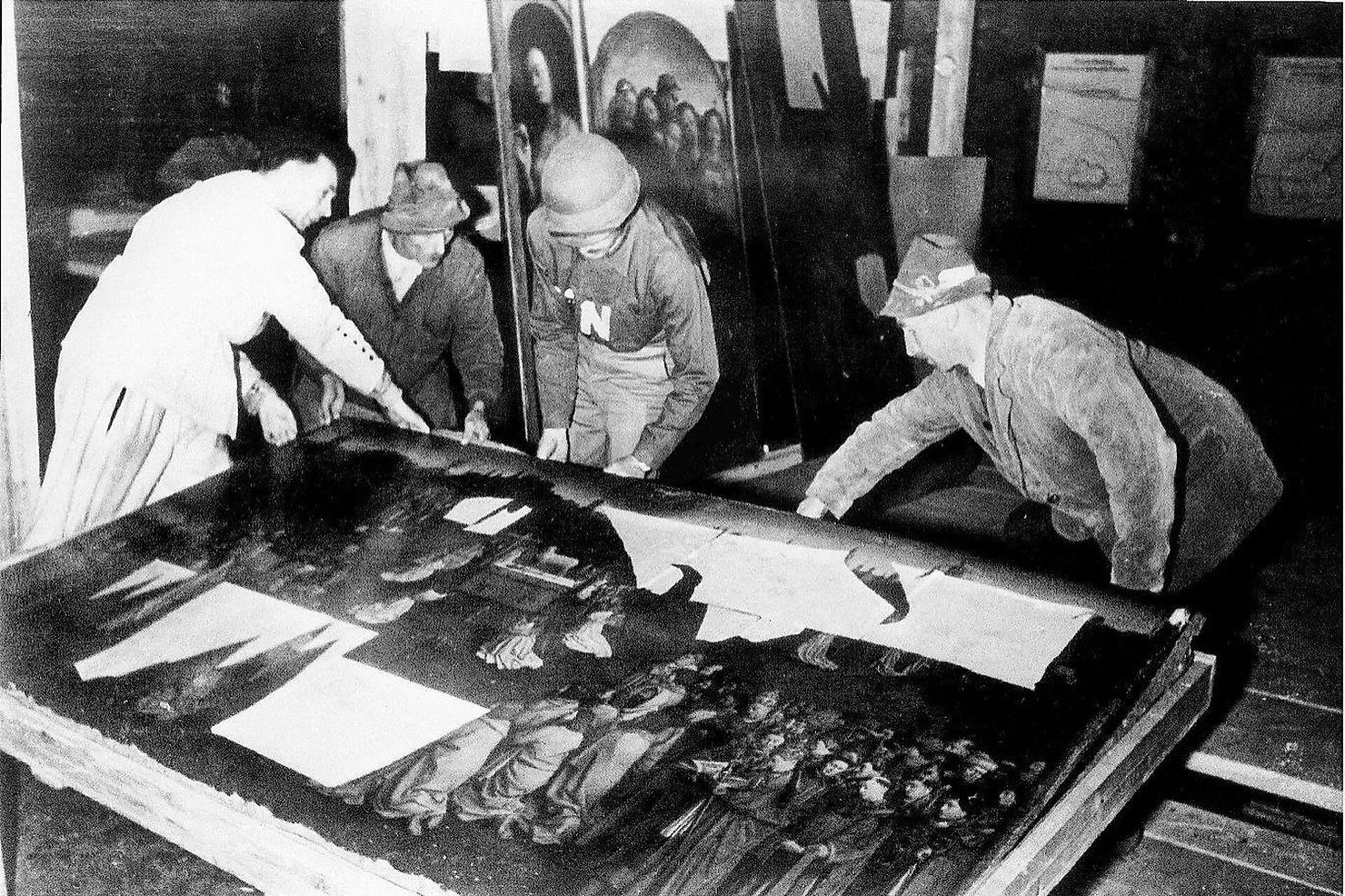The Monuments Men: The Real-Life Art Detectives of World War II
- Fernanda Matsuoka

- Mar 8
- 4 min read

Ever wondered how so many of the world’s greatest Art masterpieces managed to survive the devastation of World War II? The answer isn’t luck, but the daring work of a group of art historians, curators, and architects who became unlikely war heroes.
As Europe burned and the Nazis plundered cultural treasures to fill Hitler’s dream museum, this elite squad—known as the Monuments Men—raced against time to track down and recover millions of stolen works before they vanished forever. Their adventure is part detective story, part war epic, and part fairy tale, with castles, secret vaults, and hidden maps leading to some of the greatest rescues in history.
Their story is one of courage, ingenuity, and a relentless commitment to preserving civilization’s most cherished expressions. These were the Monuments Men, and their adventure—rivaling the best Hollywood thrillers—remains one of the greatest untold sagas of World War II.
The context: Hitler’s Grand Art Heist
Adolf Hitler’s obsession with art was deeply tied to his vision of Nazi cultural dominance. A failed artist himself, Hitler harbored resentment towards the modern art world, which he deemed “degenerate.” Instead, he sought to craft an idealized version of European art, one that reflected his rigid, classical aesthetic. His ultimate goal was the creation of the Führermuseum, a grand museum in Linz, Austria, that would house the finest art in human history—looted from across the continent.

To achieve this, the Nazis initiated a systematic plundering of European museums, private collections, and Jewish-owned galleries. Masterpieces from the Louvre, the Uffizi, and the Rijksmuseum were confiscated, and families were forced to surrender centuries-old collections. Hitler envisioned Linz, his childhood hometown, as the cultural heart of the Third Reich, where the Führermuseum would eclipse the great institutions of Europe.
However, as the war progressed, the Nazis found themselves struggling to safeguard their stolen treasures. Many artworks were hidden in salt mines, castles, and underground bunkers, awaiting the day Hitler’s vision could be realized. But that day never came—thanks in part to the Monuments Men, who risked their lives to ensure that this grand heist of culture would not succeed.
The creation of the Monuments men

In 1943, as war raged across Europe, President Franklin D. Roosevelt and Allied leaders recognized the urgent need to protect and recover the continent’s cultural treasures. In response, they established the Monuments, Fine Arts, and Archives (MFAA) program, a specialized unit tasked with safeguarding historical landmarks and retrieving looted artworks.
The individuals who took on this immense responsibility became known as the Monuments Men. They were not soldiers in the traditional sense but a diverse group of art historians, museum curators, architects, and conservators. Many of them had no military training, yet they found themselves navigating battlefields, bombed-out cities, and hidden Nazi strongholds in their quest to preserve Europe’s cultural heritage. Armed with maps, determination, and a deep respect for history, the Monuments Men became the unlikeliest of war heroes, racing against time to ensure that the artistic and historical legacy of Europe would not be lost fore
their achievements & legacy
The Monuments Men accomplished one of the greatest cultural rescue missions in history. Over the course of their efforts, they recovered nearly five million stolen cultural artifacts, including paintings, sculptures, manuscripts, and religious relics. They located and secured thousands of hidden caches of looted art, often stored in salt mines, castles, and underground bunkers across Europe, and prevented the destruction of key monuments and masterpieces during Allied combat operations.
The Monuments Men accomplished one of the greatest cultural rescue missions in history. Over the course of their efforts, they recovered nearly five million stolen cultural artifacts, including paintings, sculptures, manuscripts, and religious relics. They located and secured thousands of hidden caches of looted art, often stored in salt mines, castles, and underground bunkers across Europe, and prevented the destruction of key monuments and masterpieces during Allied combat operations.
Their work led to the rescue of treasures such as the Ghent Altarpiece, Vermeer’s “The Astronomer,” and Michelangelo’s “Madonna of Bruges,” all of which were at risk of being lost forever. Their legacy continues today, with organizations like the Monuments Men Foundation still working to locate and return missing pieces to their rightful owners.
The Film: George Clooney Brings the Story to Hollywood

The story of the Monuments Men was long overshadowed by military strategy and battlefield heroics, but in 2014, George Clooney brought it to the silver screen. The Monuments Men (starring Clooney, Matt Damon, and Cate Blanchett) dramatized the group’s efforts, blending real history with Hollywood flair. Though the film took creative liberties, it helped introduce a wider audience to this remarkable wartime effort.

Connecting Past to Present: Unique Journeys with Sapiens Travel DMC
At Sapiens Travel DMC, connecting the rich histories of the past with the present is our specialty. As you explore the lasting Dutch influence on American culture, from the Pilgrims in Leiden to the foundations of New York, we ensure that every step of your journey is carefully crafted to tell the most compelling stories.
Our tailor-made experiences are designed to bring history to life, creating meaningful connections that resonate long after your trip. Let us guide you through the hidden narratives that shaped nations, as we curate experiences that blend culture, heritage, and unforgettable memories. Contact Sapiens Travel to start planning your heritage journey today: operations@sapiens-travel.com





















